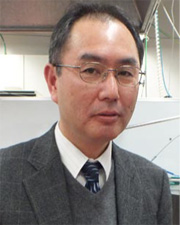Home > Highlighting JAPAN > Highlighting Japan JANUARY 2012 > Partnership in Biodiesel Synthesis
Highlighting JAPAN
COVER STORY: Tomorrow's World
Partnership in Biodiesel Synthesis
SATREPS (Science and Technology Research Partnership for Sustainable Development) is a Japan Science and Technology Agency (JST) and Japan International Cooperation Agency (JICA) program that promotes research projects involving partnerships between researchers in Japan and developing countries, with sixty projects in thirty-three countries currently in progress. A research team led by Professor Kenji Asami at the University of Kitakyushu, in collaboration with Chulalongkorn University in Thailand and other institutions, is developing a new biodiesel fuel synthesis process. Toshio Matsubara reports.

Professor Kenji Asami of the University of Kitakyushu
Credit: TOSHIO MATSUBARA
"Full-scale joint development began from FY 2011. The reason we came to harness the resources of SATREPS was because we had been engaged in ongoing basic research under Professor Kaoru Fujimoto (now emeritus professor), who is a developer of this technology and deputy leader of the project, and had been requested to make a new biodiesel by Chulalongkorn University in Thailand, with whom we were already on friendly terms. In Thailand and other parts of Southeast Asia, palm, coconut, and other vegetable oil-producing plants grow in large numbers, so if those abundant plant resources could be utilized as fuel it would be a large step forward for the environment," says Professor Kenji Asami of the University of Kitakyushu, which heads the joint development.
Biomass energy is a carbon neutral energy that does not increase CO2 in the atmosphere, and international research into biomass energy is currently moving forward in order to reduce CO2 emissions, which contribute to global warming. One form of biomass energy, biodiesel, is made from plant oil, animal oils and fats, and waste edible oil.
The common methods of producing biodiesel are the fatty acid methyl ester synthesis method known as "FAME," and the hydrocarbon synthesis method known as "BHD." These two methods of synthesizing biodiesel are, however, problematic.
FAME synthesizes by adding methanol and suchlike to the fats and oils used. This is a common method that allows biodiesel to be produced even in small-scale plants, but glycerin and other industrial waste is generated during production. Also, the synthesized fatty acid methyl ester has a low degree of purity as a fuel, as well as solidifying at 20°C or under. To be used as a fuel, therefore, it must be mixed with 10–15% of diesel oil to prevent it from solidifying.
BHD on the other hand is synthesized by processing fats and oils at high pressure using large quantities of hydrogen. Since the synthesized hydrocarbon has the same components as diesel oil, it can be used as fuel without further processing. However, it requires large-scale facilities, so at the moment can only be synthesized in petroleum refinery plants.
The research being carried out by Professor Asami and his team at SATREPS aims to establish new biodiesel synthesis technology that can be used as 100% fuel in small-scale plants, and to develop it to the stage of practical commercial application within four years.
Professor Asami explains, "With our new method, no secondary ingredient such as methanol is used whatsoever. Simply put, like BHD it synthesizes hydrocarbons using a solid catalyst. For the raw materials, vegetable oil and fat including palm, waste cooking oil, and animal oils and fats generated by meat packing plants as waste products may be used. A certain percentage of hydrocarbons is generated as a by-product, and it is planned to use this as a source of heat for manufacturing plants."
The new biodiesel synthesis method first coats the surface of the activated carbon and silica with magnesium oxide, creating a solid catalyst in the form of particle sizes of around 1.2 mm. This solid catalyst is packed in a reactor, and heated to 400–430°C while stirring. When the fats and oils that will become the raw material are poured in, a catalytic reaction occurs and the molecules of fats and oils are decomposed, and the vaporized gas is discharged through a pipe to a separate container. This is then cooled, allowing new biodiesel hydrocarbons to be synthesized. With this new method of production, both the plant manufacturing costs and operation costs are quite low. Engine tests using hydrocarbons generated with this method have already been carried out, and it has been demonstrated that combustion occurs without any problem.
The kick-off meeting for this project was held in May 2011 in Thailand. Between August and October seven young researchers from Chulalongkorn University visited the University of Kitakyushu, where each of them spent one month learning experimental techniques. "They already had the basic knowledge, but it was their first time to take part in an experiment, and they were very enthusiastic. Their zeal for research came across loud and clear," says Professor Asami.
The two research themes for the future are to further increase the capability of the catalyst, and to develop a more efficient reaction method. "Currently, the amount of hydrocarbons that can be synthesized is around 60% of the fats and oils that are the raw materials, but by actively advancing research through international cooperation between the two universities we aim to raise this to 80%, which is close to the ideal figure."
The project also eyes the possibility of using coconut shell, a natural material, as a candidate for the activated carbon used in the solid catalyst. Looking further ahead, in the future the researchers will also look at whether hydrocarbons can be synthesized by inputting palm or coconut itself directly into a reactor, eliminating the process of converting it into vegetable oil. It is planned to commence the construction of a pilot plant in Thailand in 2012, with a view to establishing the technology for new biodiesel synthesis.
© 2009 Cabinet Office, Government of Japan






